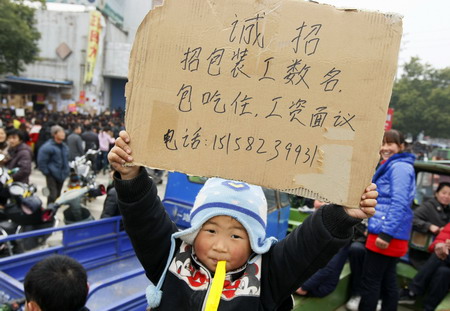Economy
Labor shortage sparks calls for growth reform
By Hu Yuanyuan (China Daily)
Updated: 2011-03-02 15:21
 |
Large Medium Small |
|
 |
|
A child holds a recruitment poster outside the Datang job market in Zhuji on Feb 19. [Photo / China Daily] |
In November, the Chengdu city government launched a program to attract the local labor force to stay by offering them more support in starting their own business and addressing the education difficulties for their children.
Sichuan used to be a major province exporting laborers to coastal areas.
China's labor shortage will be a long-term problem, rather than a short-term worry after the Spring Festival, economists said.
Stephen Green, a China economist with Standard Chartered, said new jobs hit 20 million to 25 million last year, more than doubling the official statistics.
"The growth pace of new jobs will exceed the increase of workers, and the situation will deteriorate in the following decade," said Green. "We estimated the growth rate of the labor population will be close to zero in the following years, so improving efficiency is key to sustaining economic growth."
|
||||
This development, which first occurred in 2009, suggests that the proportion of the workforce to the population as a whole is close to peaking.
"These labor market trends are intricately linked to China's ongoing economic restructuring and helpful to sustaining growth," said Sun Chi, an economist at Nomura Securities.
China has decided to seek a more balanced growth model and reduce the proportion of exports and investment in the economy. Premier Wen Jiabao said earlier that China will address "structural problems" and "we can rely on stimulating domestic demand to stabilize and further expand the Chinese economy".
Consequently, the country needs a larger wage share in national income to help rebalance its growth towards consumption.
| 分享按钮 |



